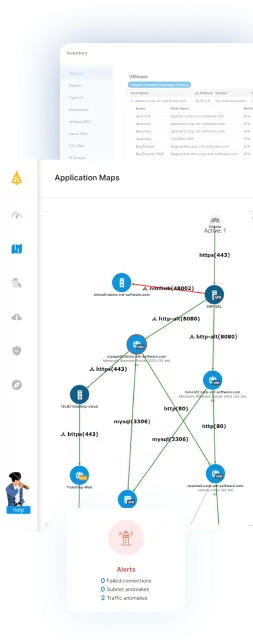What Is AI-Driven Network Security?
AI-driven network security uses artificial intelligence technologies to monitor, identify, and respond to threats within digital networks. Unlike traditional security systems that rely on predefined rules and manual configurations, AI-powered solutions leverage machine learning, data analysis, and pattern recognition to adapt as new threats emerge.
These systems process large volumes of network data, spot anomalies quickly, and help security teams make informed decisions at speed. This approach can also automate complex threat detection tasks that previously required significant human intervention. By integrating AI, organizations can better defend against sophisticated attacks, as the technology continuously learns from network traffic, user behavior, and evolving attacker tactics.
This is part of a series of articles about IT mapping
Table of Contents
Toggle- What Is AI-Driven Network Security?
- Why Is AI in Network Security Important?
- Applications of AI in Network Security
- Tips from the Expert
- Benefits of Implementing AI in Network Security
- Challenges and Considerations When Implementing AI in Network Security
- Best Practices for AI-Driven Network Security
- AI-Driven Network Security with Faddom
Why Is AI in Network Security Important?
Network security is crucial for protecting digital infrastructure against threats that can compromise data integrity, confidentiality, and availability. Understanding these threats is key for implementing effective security measures.
Traditional network security tools, such as firewalls, antivirus software, and intrusion detection systems (IDS), counter known threats using predefined rules and signatures. However, the evolving landscape of cyber threats has exposed significant limitations in these conventional approaches.
Limitations of traditional security tools:
- Static rule sets: Traditional tools rely on fixed rules and known threat signatures. This approach is ineffective against novel or rapidly evolving threats that do not match existing patterns.
- Limited visibility: These tools often lack monitoring capabilities across modern, complex network environments, including cloud services and remote endpoints. This limited visibility hampers the detection of sophisticated attacks.
- Reactive nature: Conventional security measures typically respond to threats after they have been identified, rather than proactively anticipating and mitigating potential attacks.
- Alert fatigue: High volumes of alerts, many of which may be false positives, can overwhelm security teams, leading to important warnings being overlooked.
- Inadequate handling of advanced threats: Sophisticated attacks, such as advanced persistent threats (APTs) and zero-day exploits, often bypass traditional defenses due to their complexity and stealth.
Related content: Read our guide to AI security tools (coming soon)
Applications of AI in Network Security
Intrusion Detection and Prevention Systems (IDPS)
AI-powered IDPS can analyze massive volumes of network data to identify potential intrusions. These systems move beyond static rule-based detection by using machine learning algorithms to recognize subtle deviations from normal network behavior. As a result, they are better equipped to detect zero-day threats or insider attacks that may not match known signatures.
AI can also automate the categorization and prioritization of alerts, reducing analyst fatigue. Advanced AI models in IDPS continuously retrain themselves as new data becomes available. This adaptability is crucial for handling the dynamic tactics employed by cybercriminals. Instead of relying on manual rule updates, AI-driven systems can adjust to novel attack vectors.
Automated Threat Intelligence and Response
AI improves threat intelligence platforms by automatically collecting, correlating, and analyzing external threat data, such as information on malware campaigns and attack infrastructures. Instead of relying solely on human analysis, AI synthesizes data from multiple sources to provide immediate insights and actionable intelligence.
Once a threat is identified, AI-driven security systems can initiate automated response actions. These may include isolating affected endpoints, blocking malicious network traffic, and updating firewall rules in real time. By automating routine response measures, organizations reduce the window of vulnerability and free up security personnel to focus on higher-level analysis.
Phishing and Malware Detection
Phishing attacks have become more sophisticated, often bypassing basic security filters. AI models trained on vast datasets of email content, URLs, and attachments can detect subtle signs of phishing, such as misleading sender addresses or suspicious payloads. These systems adapt as attackers’ techniques evolve, automatically flagging new patterns.
Malware detection also benefits from AI’s pattern recognition and anomaly detection capabilities. Traditional signature-based methods can miss novel malware variants, but AI systems scrutinize file behaviors, network activities, and system changes to identify threats in real time.
Network Traffic Analysis and Segmentation
AI-driven traffic analysis tools continuously monitor data flows, detecting unusual patterns that could indicate breaches, lateral movement, or data exfiltration attempts. Machine learning models can base alerts on changes in network behavior, flagging threats that may not trigger traditional controls. AI automates this analysis to maintain network visibility without overwhelming human analysts.
Network segmentation benefits from AI’s dynamic profiling of assets and users. By understanding usage patterns and communication channels, AI can suggest optimal segmentation policies that minimize the attack surface.

Lanir specializes in founding new tech companies for Enterprise Software: Assemble and nurture a great team, Early stage funding to growth late stage, One design partner to hundreds of enterprise customers, MVP to Enterprise grade product, Low level kernel engineering to AI/ML and BigData, One advisory board to a long list of shareholders and board members of the worlds largest VCs
Tips from the Expert
In my experience, here are tips that can help you better implement and operationalize AI-driven network security:
- Combine AI detection with deception-based defenses: Use AI to dynamically adjust honeypots and decoys in the network. These assets lure attackers, gather threat intelligence, and train AI models on real attacker behaviors without exposing critical systems.
- Employ federated learning to protect sensitive data: Instead of centralizing all network traffic for AI training, use federated learning models that train on decentralized data. This minimizes privacy risks and ensures compliance while still improving AI effectiveness.
- Design AI models for adversarial robustness: Harden AI systems against adversarial attacks by training them with obfuscated and poisoned data samples attackers might use. Incorporate techniques like ensemble models and randomization to make evasion harder.
- Leverage AI for dynamic microsegmentation: Go beyond static network segmentation by using AI to continuously analyze traffic patterns and adjust microsegments in real time. This minimizes the blast radius of any compromise.
- Implement AI-driven SLA monitoring for security controls: Have AI monitor the effectiveness and latency of existing controls (e.g., firewalls, IDPS, proxies) in real time, alerting teams when they degrade under load or miss anomalies.
Benefits of Implementing AI in Network Security
Integrating artificial intelligence into network security offers numerous advantages that address the shortcomings of traditional tools and help organizations defend against increasingly sophisticated cyber threats:
- Proactive threat detection: AI systems continuously learn from network behavior and can detect threats based on emerging patterns, allowing them to identify risks before they cause harm. This anticipatory capability moves security postures from reactive to proactive.
- Reduced response time: Automated analysis and real-time decision-making significantly shorten the time between threat detection and mitigation. AI can take immediate action—such as blocking traffic or isolating endpoints—without waiting for human intervention.
- Scalability for large networks: AI-driven tools can analyze vast amounts of data from complex, distributed environments including cloud, on-premises, and hybrid networks. This scalability enables consistent monitoring across diverse infrastructure without a proportional increase in staffing.
- Lower false positives: Machine learning algorithms refine detection accuracy by recognizing context and learning from past alert patterns. This reduces alert fatigue and helps analysts focus on genuine threats rather than chasing false alarms.
- Continuous adaptation to evolving threats: Unlike static rule-based systems, AI models retrain on new data, adjusting to novel attack vectors and tactics. This continuous learning ensures defenses stay relevant in the face of dynamic threats.
- Improved resource efficiency: By automating repetitive and time-consuming tasks, AI allows security teams to concentrate on strategic initiatives, incident forensics, and complex threat analysis, optimizing both time and talent.
Challenges and Considerations When Implementing AI in Network Security
Data Privacy and Ethical Concerns
The use of AI in network security often involves processing large volumes of sensitive data. Collecting and analyzing this data poses significant privacy challenges, as organizations must ensure compliance with regulations such as GDPR and CCPA. The risk of data misuse or unauthorized access is heightened, especially if AI models are trained on personally identifiable information or proprietary business records.
Ethical challenges center around the transparency and accountability of AI-driven decisions. Without strong governance, organizations may inadvertently deploy biased models or make security choices that lack clear justification. Ensuring privacy, protecting data throughout its lifecycle, and maintaining user trust are critical hurdles for adopting AI in security contexts.
Adversarial Attacks on AI Models
AI security systems are themselves susceptible to adversarial attacks. Malicious actors can exploit weaknesses in machine learning models by crafting deceptive inputs—such as obfuscated malware or modified traffic patterns—that evade detection. These adversarial examples can undermine the reliability of AI tools, creating blind spots for defenders.
Ongoing research and testing are necessary to harden AI models against such attacks. Organizations must employ strategies like adversarial training, regular model evaluation, and layered cybersecurity defenses to mitigate risks. A failure to anticipate and address adversarial threats could result in AI solutions being manipulated by skilled attackers.
Integration with Existing Security Infrastructure
Integrating AI solutions into existing network security architecture can be complex. Legacy systems may not natively support AI-driven processes, requiring organizations to bridge gaps through middleware, APIs, or custom configuration. Ensuring interoperability and minimizing downtime during integration are key considerations for a seamless transition.
Staff must be trained to operate and maintain AI-enhanced systems, which may require new skills or workflows. A phased rollout, combined with thorough testing and documentation, helps minimize integration challenges.
Best Practices for AI-Driven Network Security
Organizations should consider the following practices to ensure an effective network security strategy using AI.
1. Develop a Strategic Roadmap
A clear strategy is essential when implementing AI in network security. Organizations should begin by assessing their current security landscape, identifying pain points, and determining where AI can offer the most value. The roadmap should outline objectives, success metrics, and the resources needed to achieve each milestone, aligning AI investments with overall business goals.
Stakeholder engagement is crucial throughout this process. Involving IT, security, compliance, and executive teams ensures that priorities are aligned and risks understood. This collaborative approach helps anticipate operational challenges and drives smoother adoption of AI-driven capabilities, maximizing their impact on organizational cybersecurity.
2. Prioritize Data Governance
Reliable AI models require high-quality data, making governance a foundational concern. Effective data governance includes establishing policies for data collection, labeling, retention, and access controls. By ensuring that only relevant and accurate data feeds AI systems, organizations reduce the risk of skewed or biased models and maintain regulatory compliance.
Continuous monitoring and auditing of data pipelines are also vital. Regular checks for integrity and privacy help prevent unauthorized use or leakage of sensitive information. Investing in strong data stewardship practices lays a foundation for trustworthy AI that supports defensible network security outcomes.
3. Integrate AI with Existing Security Ecosystems
Successful AI-driven security depends on how well new technologies integrate with current systems. Leveraging APIs, plug-ins, or orchestration platforms, organizations should prioritize interoperability to avoid siloing critical threat intelligence and workflows. This integration simplifies data sharing, incident response, and threat analysis across the entire security stack.
Collaboration between vendors and in-house teams is also essential. Open communication allows for rapid troubleshooting, optimized configurations, and the development of tailored solutions. A focus on seamless integration helps maximize ROI and ensures that AI improves, rather than complicates, a company’s existing security posture.
4. Continuously Train and Update Models
Threat landscapes are dynamic, with new attack vectors and techniques emerging regularly. AI models must be retrained frequently on the latest threat intelligence, network logs, and behavioral data to maintain accuracy and relevance. Regular updating helps prevent models from becoming obsolete or vulnerable to evolving threats.
Automation can support this process by periodically retraining models or incorporating new data without manual oversight. However, continuous human oversight remains critical to validate model outputs, detect drifts or biases, and intervene in complex scenarios. Maintaining an ongoing feedback loop between human expertise and AI systems ensures resilient networks.
AI-Driven Network Security with Faddom
As organizations adopt AI to enhance their network security, it’s essential to select tools that provide real-time insights, adaptability, and operational clarity. Faddom embodies this approach with its AI-powered anomaly detection engine, which continuously learns the unique behaviors of your environment and identifies suspicious traffic without requiring manual rule-setting or constant monitoring. This proactive detection ensures that emerging threats, such as DDoS attacks, DNS spoofing, or data exfiltration, are detected early, even if they do not align with known patterns.
In addition to detection, Faddom emphasizes response through contextual risk scoring. This feature enables teams to quickly identify the most vulnerable servers by considering factors such as network behavior, access patterns, and exposure levels. Consequently, organizations can achieve faster mitigation, reduce alerts, and gain a clearer understanding of where to focus their security efforts.
By combining accurate traffic analysis with built-in privacy features and enhanced visibility into shadow IT, Faddom empowers organizations to effectively operationalize AI in response to today’s evolving security challenges.







